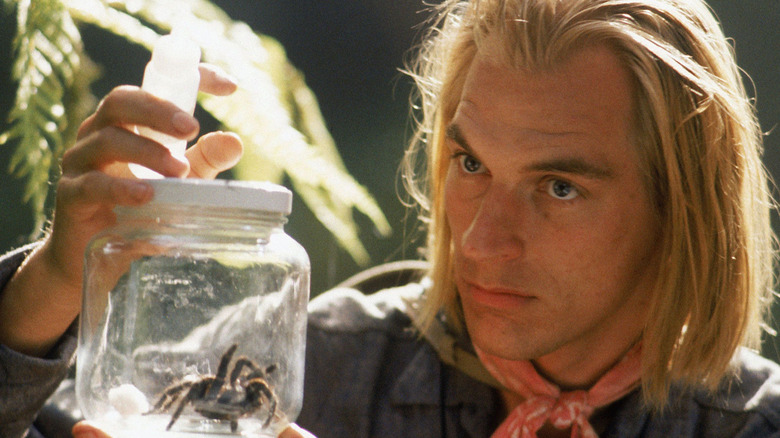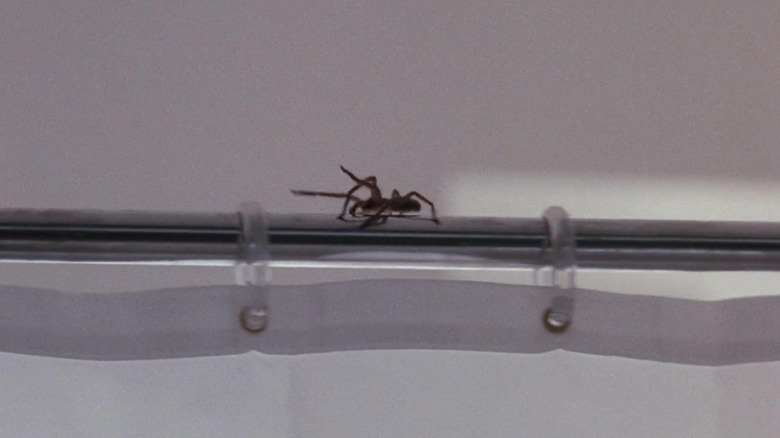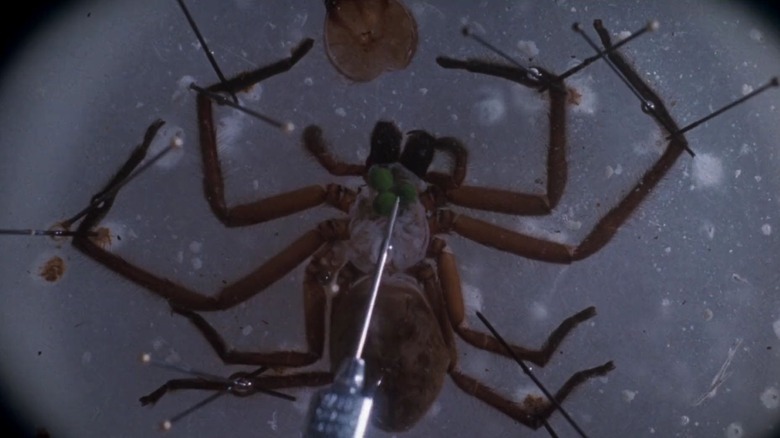Arachnophobia's Spider Wrangler Invented A Genius Technique For Controlling Spiders
Cinematically speaking, spiders are having a miniature moment. On April 12, 2024, fans of creature features were treated to Kiah Roache-Turner's "Sting," a film about an alien spider that grows to an enormous size and terrorizes the denizens of a run-down apartment building. Then, on April 26, the United States was granted access to Sébastien Vanicek's "Infested" (French title: "Vermines"), a film about many spiders that grow to enormous sizes and terrorize the denizens of a run-down apartment building. These two films, of course, came hot on the heels of the February release of "Madame Web," the best Spider-Man-adjacent, non-Marvel-Cinematic-Universe-related mid-budget clairvoyance caper film ever made.
Children of the '90s may be getting flashbacks to the glories of Frank Marshall's 1990 spider horror/comedy "Arachnophobia," one of the more exciting mainstream horror films of its era. In "Arachnophobia," a venomous Venezuelan spider is accidentally shipped to the United States, finding its way to the small town of Canaima, California. It mates with a local spider and produces hundreds of large, fast-moving, aggressive, ultra-poisonous offspring. It will be up to arachnophobe Jeff Daniels and comedic exterminator John Goodman to eradicate all the spiders before they bite and kill everyone in town. The late Julian Sands plays the stern-faced spider expert.
While some of the spiders were puppets, most of them were played by real animals. Noted bug wrangler Steven Kutcher was interviewed in the most recent issue of Empire Magazine, and he described the "audition" process for the various spider species they considered for "Arachnophobia," as well as his unique way of getting the critters under control. It seems all one needs is a vibrating engine, some long thin wires, and a portable heater.
How Arachnophobia's spider wrangler coaxed the spiders into doing his bidding
Kutcher said that finding a good spider species suitable for filming was a month-long process. He and Jules Sylvester, another one of the film world's more notable bug wranglers, cycled through various species, hoping to find bugs that were willing to climb around actively on film sets. Spiders can't really be trained, so they had to have a natural inclination for "performance," as it were. He found that the Australian species delena cancerides, also known as the Avondale spider, fit the bill perfectly. Avondale spiders have inch-long bodies, long legs, and vicious-looking "fangs." They hide under bark and tend to lay flat, spreading their legs in a scary fashion. Despite their scary faces, Avondale spiders are not venomous and tend to leave humans alone. They're also social animals and tend to live in large colonies, making the "Arachnophobia" climax that much easier to shoot; of course there will be a scene where Jeff Daniels has to face off against hundreds of spiders at once.
Kutcher ordered 500 Avondales from New Zealand, and they were off to the races. The spider races. Specifically, the spider races into a human slipper.
To convince a spider to climb into the slipper, Kutcher needed to invent a new technique to push a spider along. Ordinarily, to push a spider, a bug wrangler will construct a miniature wire "fence" to bump the bug in a certain direction. That wasn't an option for "Arachnophobia," however, as the fence would be visible from the camera angle Frank Marshall wanted.
Kutcher, rather brilliantly, attached two pieces of thin tungsten wire to a pair of small vibrating motors. The wire shook so quickly, it wouldn't be seen on film.
The Arachnophobia bug wranglers also used heat to manipulate the spiders
With the tungsten wires in place, Kutcher was able to push the spider along however he wanted. Because film runs through a camera at 24 frames per second, the "fluttering" effect effectively kept the wire from being filmed. Then, to make sure the spider actually walked forward, Kutcher used a heat gun. Spiders flee from heat, making it an effective way to herd the animals.
Kutcher was impressed with his own brilliance, telling Empire, "That was a little bit of genius, I have to admit."
He has long been a Hollywood institution, providing bug actors for dozens of feature films starting in 1977. He provided all those grasshoppers (playing locusts) for "Exorcist II: The Heretic," and the dragonflies for "A Nightmare on Elm Street 3: Dream Warriors." He oversaw the mantises in the bonkers bug-themed horror/comedy "Meet the Applegates," and stuffed maggots into fake dead bodies in "L.A. Confidential" (which remains one of the best movies of the '90s). He's worked with cockroaches, scorpions, tarantulas, bees, ants, termites, moths, and, in one daring departure from his usual menagerie, the newt in "Matilda." He's also been hired to work on various music videos; he provided the scorpions in Alice Cooper's "Welcome to My Nightmare," and the flies in No Doubt's "Don't Speak," along with several others.
Keep an eye on your local natural history museums as well, as Kutcher regularly hosts bug workshops for kids, teaching them early entomology and displaying members of the insect kingdom with aplomb. He also teaches biology and zoology classes at local community colleges in Los Angeles.


